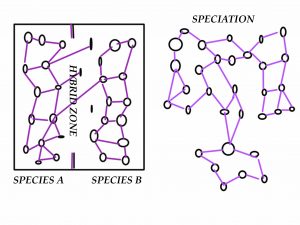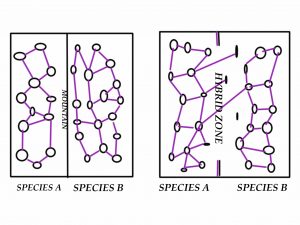Hybridization: Linking Giant Components
Link: http://www.annualreviews.org/doi/pdf/10.1146/annurev.es.16.110185.000553
Summary:
This paper delves into the phenomenon of Hybridization. What is hybridization? Hybridization is the process by which two genetically and phenotypically variant species meet and mate to produce “hybrids.” Say for example, we have two species of butterflies. These butterfly species may have had some commonalities in the past, but some kind of separation event forces them to be apart for an extensive period, allowing them to evolve differently. Hybridization comes into scope when the separation force is removed and these different butterfly species resume contact and produce hybrids. As a result, the location where this interbreeding occurs, becomes a hybrid zone. These zones can further be characterizing as either primary or secondary hybrid zones. A primary hybrid zone originates when natural selection acts on a geographic gradient to produce two distinct populations who still interbreed. Whereas a secondary hybrid zone originates when two diverging populations once separated by barrier (mountains, water…etc.) resumes contact upon the disappearance of the barrier and interbreed. Summarily primary hybridization is in regard to natural selection while secondary is to geography.
The articles further examine how these locations are quite interesting. It is the job of the taxonomist to categorize organism into groups, on the terms of relatedness, characteristics, or genetic. But with hybrids this it is not as simple. These locations can be taxing for scientist since hybrids they have already established a definition for the term “species” but hybrids do not quite fit into this definition; Hybrids are neither reproductively isolated organisms, or have a existing gene flow. Despite its perplexing nature, we can all agree that hybridization promotes speciation. When these two genetically different specials come together, they can create a hybrid, that is also genetically different for itself. Deeper into the paper, Barton and Hewitt talk about these graphs called clines, which are created from data collected from hybrid zones, and allows scientists to tell whether a hybrid zone is the product of primary or secondary contact.
How does it relate to networks?
In class, we asked the question “Could the global friendship network have two distinct giant components?” and we were able to say, almost surely not since any link between a person in each giant component would make them all one component. Similarly, in hybridization, due to some barrier, a species can split into two sub species to make two giant components (metapopulations). As a result, the two sub-population are left to network among themselves: interbreeding, and growing genetically differently from its relatives on the other side of the barriers. Overtime these barriers, in geography for example, can be removed, and the species can resume contact with their distant relative. Hybridization then allows these two big components to links and resume their friendship networks, to make one network. This is just say two giant components may appear independent, but it is in their nature that these components would connect.
The links of these two components through hybridization can result in the forming of a new big component of the new hybrid species that will be linked to both of its parent species. This is to say that, there we may have possibly have two big components initially, but hybridization would allow contact and speciation, so that from all the interbreeding a new hybrid population is formed, which in the end can have its only giant component with hybrid networking together while connected with the other network.


